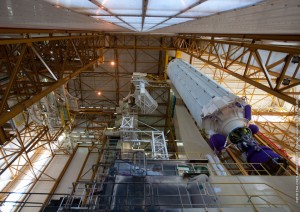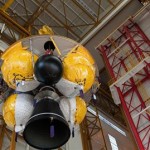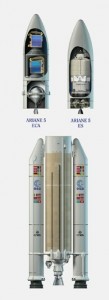The launch of the ESA’s second ATV cargo vessel will not only be important for resupplying the International Space Station, but also for the Ariane launcher itself: it will be the 200th flight of this European launcher!
Ariane 5 is the latest version of Ariane launcher family, which has been in operation since 1979. The original Ariane 1 was soon replaced with heavier versions and the original Ariane design retired with Ariane 4 in February 2003. Since then, Ariane 5 has ‘taken care of business’, and now this 200th Ariane flight will be the 56th lift-off for this heavy-weight rocket.
There are now two main variants of Ariane 5: the the Ariane 5 ECA for geostationary transfer orbit missions, and ES version for flights to low- and medium-Earth orbits; ATV will use the ES version.
The main difference between the ECA and ES lies in the vehicle equipment bay (VEB) of the launcher’s upper stage, which has been designed to withstand flight loads with the ATV and to be re-ignitable. Firing the upper stage rocket up to three times makes the orbit insertion much accurate and ensures that the used upper stage will safely re-enter the Earth’s atmosphere.
Otherwise, Ariane 5 ES is composed of the same lower composite, identical boosters and the same cryogenic main stage equipped with the Vulcain 2 engine as Ariane 5 ECA.
This 200th Ariane for ATV Johannes Kepler was assembled in December 2010, inside the Spaceport’s high Launcher Integration Building, by positioning the core cryogenic stage over the mobile launch table and mating two large solid rocket boosters with the core stage.
ATV-2, now already fuelled and almost ready to go, will be mated with the launcher later this month to start the combined operations between the Ariane and ATV teams, all targeting launch on 15 February 2011.
Ariane 5 ES for ATV in numbers:
Height 53 m
Diameter 5.4 m
Liftoff mass 760 tonnes
Payload mass up to 21 tonnes




 Automated Transfer Vehicle page
Automated Transfer Vehicle page ATV blog archive
ATV blog archive
Discussion: no comments